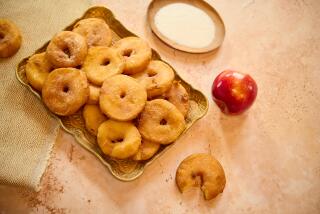For Rosh Hashanah, honey, you have options
It doesn’t matter whether you were born in Brooklyn or Borneo — if you’re Jewish you’ll probably include honey on your shopping list for Rosh Hashanah, the Jewish New Year, which begins on the evening of Sept. 28. Like most Jewish holidays, Rosh Hashanah is celebrated by extensive praying and expansive eating, but it is the only holiday in which honey plays a starring role.
On Rosh Hashanah, it’s not enough just to wish our brethren a “Happy New Year” — tradition holds that we wish them a sweet year as well. Thus, the festive meal opens with a centuries-old custom of dipping apple slices into honey, followed by dipping challah into honey (rather than into salt, as is done with bread the rest of the year). And the meal often ends with the ubiquitous spiced honey cake (which has very few actual fans but is always evident nonetheless).
But honey is so versatile that it weaves its way into other parts of the holiday meal as well — replacing the sugar added to the traditionally sweet, round Rosh Hashanah challah, and brushed on the crust before baking. (I bake it with a small ovenproof bowl in the center, which I later fill at the table with honey for dipping.)
Sometimes, just a touch of honey will do, like in the honey-mustard dressing I use to moisten and bind a delicious smoked fish salad, a far easier alternative to gefilte fish — and one that can be made up to 24 hours in advance. It’s also used in the marinade for chicken stuffed with brown rice and grapes, where it gives the bird an appealing golden-brown glaze.
And, of course, honey is infinitely suitable to add to dessert. But this year you may want to forgo, or at least postpone, a rich dessert or honey cake for a refreshing “carpaccio” of paper-thin fresh fruit, drizzled with a sauce made in minutes with honey, lime, ginger and fresh mint. This is a good time to take out that kitchen mandoline from the back of the drawer, or use your sharpest knife to slice the fruit as thinly as possible.
Why this love affair with honey? It has been a fundamental part of Jewish lore since ancient times, mentioned throughout the Bible as a metaphor for fertility, health and goodness.
On that fateful day when God spoke to Moses at the burning bush, he promised to bring the Israelites to “a land flowing with milk and honey,” whose abundance would provide both basic sustenance and the sweetness of simple joy. And in the meantime, while wandering in the desert, the Israelites would subsist on manna, a “perfect food” — white like coriander seed and tasting like wafers made with honey, as the Bible describes it.
The prophet Isaiah considered honey and milk especially nourishing for children, and when King Saul’s son Jonathan was weak and weary, honey “brightened his eyes.” The Talmud relates that honey was also considered a preservative, and not just for food: King Herod preserved the body of his beloved in it for seven years.
In those days, honey mixed with barley flour was recommended by the sages to alleviate stomach pains and weakness of the stomach or heart.
The Book of Proverbs equates the beneficial wholesome properties of honey to those of wisdom but cautions against overindulgence. (Wise advice, to be sure — but somewhat difficult to follow on the holidays.)
Truth be told, biblical scholars agree that the “honey” of the Bible was not made by bees but from dates, figs, carob or grapes. To make date, fig or carob honey, the fruit was soaked in water until fully softened and then cooked down to a thick syrup. Date and grape honeys were the most popular, followed by fig honey. Carob honey held last place because of its distinctive aroma. You can find updated versions of these venerable sweeteners on a visit to a health food or Middle Eastern store. Just avoid any that contain added sugar.
This Rosh Hashanah, you might also like to try working with infused honeys flavored with spices such as whole cinnamon, black pepper, fennel or ginger, or fresh herbs like mint, rosemary, thyme, lemon balm or lemon grass.
Begin with honey (preferably a raw light variety) and add a few sprigs of fresh herbs, three cinnamon sticks or a few tablespoons of whole spices to an 8-ounce jar. You can either store the jar on the countertop, shaking and tasting occasionally until you achieve the desired intensity of flavor, or use the quick method: Heat the honey on the lowest possible heat until a white film appears, and let cool slightly. Strain through a wire-mesh strainer, pack in sterilized jars and store in the refrigerator.
Not fond of honey? Try agave syrup. It has a similar color and a more neutral flavor. And who knows? It might even improve the taste of that honey cake.
More to Read
Eat your way across L.A.
Get our weekly Tasting Notes newsletter for reviews, news and more.
You may occasionally receive promotional content from the Los Angeles Times.










